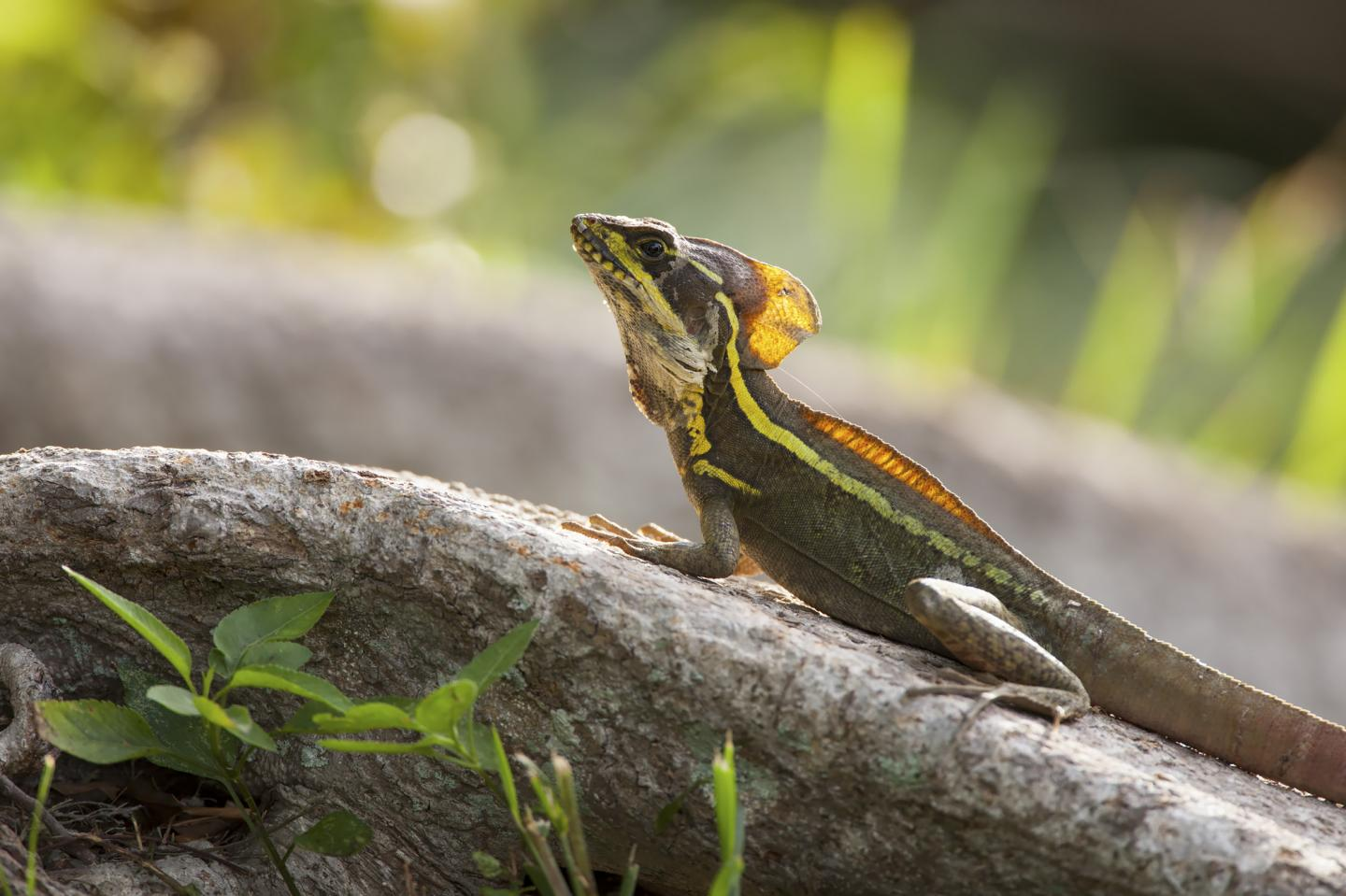Oct 21 2020
On a sunny morning, it was raining iguanas.
 Central American brown basilisks (Basiliscus vittatus) are among the members of a lizard community that converged on a lower temperature tolerance after a cold snap in Miami. Image Credit: Day’s Edge Productions.
Central American brown basilisks (Basiliscus vittatus) are among the members of a lizard community that converged on a lower temperature tolerance after a cold snap in Miami. Image Credit: Day’s Edge Productions.
Early on January 22nd, 2020, biologist James Stroud’s phone began ringing. A friend bicycling to work past the white sands and palm tree edges of Key Biscayne, an island town located to the south of Miami, sent Stroud a photo of a 2-foot-long lizard splayed on its back. The iguana occupied most of the sidewalk with its feet in the air.
The night before was the coldest one for south Florida in a decade, at under 40 °F. When the majority of people sought a pair of socks or an extra blanket, Stroud, a postdoctoral research associate in Arts and Sciences at Washington University in St. Louis, desperately texted a collaborator: “Today’s the day to drop everything, go catch some lizards.”
When temperatures drop below a critical limit, sleeping lizards tend to lose their grip and fall off trees. From earlier research, Stroud and his colleagues had discovered that various types of lizards in Miami endure different low temperatures, ranging from around 46 to 52 °F before they are shocked by cold. This cold snap offered an exclusive chance to understand how they are influenced by extreme climate events.
However, when the scaled survivors of that coldest night were collected, they learned that the lizard community reacted in a surprising way: all of them could withstand cold temperatures down to approximately 42 °F, irrespective of the former ability of their species to endure cold. The study results have been published in the October 21st issue of the Biology Letters journal.
Prior to this, and for a different study, we had measured the lowest temperatures that six lizard species in south Florida could tolerate. We realized after the 2020 cold event that these data were now extremely valuable—we had the opportunity to re-measure the same lizard populations to observe if their physiological limits had changed; in other words, could these species now tolerate lower temperatures?
James Stroud, Postdoctoral Research Associate, Arts and Sciences, Washington University in St. Louis
After the January cold snap, scientists gathered specimens of as many varied kinds of lizards as they could locate in the local area, capturing both small and large lizards and those that are active during the day and those at night. Then, their reaction to cold was tested.
“A major unexpected result of this study was that all species converged on the same new, lower level of thermal tolerance,” Stroud added. “While there was great variation in temperature tolerance before the cold event—some, like the large-bodied brown basilisk, were very intolerant of low temperatures, while others like the Puerto Rican crested anole were more robust—we observed that all species could now tolerate, on average, the same lowest temperature.”
“Given great variation in body size, ecology and physiology, this was unexpected,” he said.
Just one of the species in the research is native to the locality; the remaining ones were introduced to Florida in the last 100 years, researchers observed.
The findings offer proof that tropical, cold-blooded creatures—usually described as incapable of enduring rapid variations in climatic conditions—can occasionally withstand conditions that surpass their typical physiological limits.
“The shifts to tolerate significantly lower temperatures that we observed were so large that we found it unclear whether natural selection was responsible,” Stroud noted. “And so in our paper, we discuss other alternative processes which may also have led to this pattern.”
The results of this study are surprising and unexpected. Who would have thought that tropical lizards from places like Puerto Rico and Central America could withstand temperatures near freezing?
Jonathan Losos, William H. Danforth Distinguished University Professor and Professor of Biology in Arts and Sciences, Director of the Living Earth Collaborative, Washington University
Losos added, “What we now need to find out is how this was accomplished. Is this evidence of natural selection, with those lizards that just happened to have a lower cold tolerance surviving and others freezing to death, or was it an example of physiological adjustment—termed ‘acclimation’—in which exposure to lower temperatures changes a lizard’s physiology so that it is capable of withstanding lower temperatures?”
Irrespective of the fundamental mechanism, the new research offers a crucial piece of information for comprehending the effects of climate change.
Researchers predict that air temperatures will slowly turn warmer under climate change and that temperatures will turn out to be more disorderly.
Events that increase the temperature to extremes—both very hot and very cold episodes—will increase in magnitude and frequency. Thus, it is crucial to comprehend both the impacts of a steady, long-term rise in air temperatures as well as the impacts of abrupt, short-term extreme events.
It is widely thought that tropical and subtropical species are going to be especially vulnerable to changes in temperature—particularly extreme spikes of heat or cold—as tropical areas do not typically have strong seasons. Unlike temperate species, which are adapted to summer highs and winter lows, tropical species have typically evolved in very thermally stable environments.
James Stroud, Postdoctoral Research Associate, Arts and Sciences, Washington University
“While there is no doubt that climate change represents a major threat to species and ecosystems around the world, and deserves as much research attention as possible, this study provides fascinating insight and a glimpse of hope. Perhaps tropical and subtropical species can withstand more extreme climatic conditions than we expect,” concluded Stroud.
Journal Reference:
Stroud, J. T., et al. (2020) An extreme cold event leads to community-wide convergence in lower temperature tolerance in a lizard community. Biology Letters. doi.org/10.1098/rsbl.2020.0625.